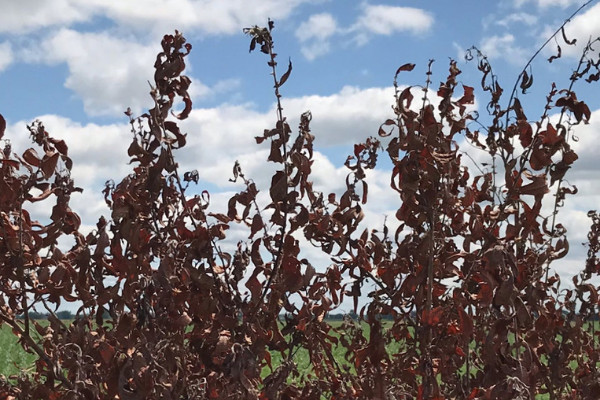
Herbicide-killed brush along a road in Midland County, MI
American Chemical Society | Industry | Industry Matters Newsletter | Life-giving and Life-Taking Chemistry
Life-Giving and Life-Taking Chemistry:
Toxic is sometimes what you want
Industry Matters Newsletter 14 October 2021
It is early September.
The power of chemistry to give life and the power of chemistry to kill
are both on display here in mid-Michigan.
The corn now stands well more than head-high.
The tassels are past peak, just beginning to look a little tattered.
Fields, orchards, and forests look robust this year.
Most corn fields are beautiful, dark green, highlighted by the yellows of
tassels and silk.
While most of the corn in the fields looks great, there are
exceptions. Sections in some fields
recall the best efforts of
Oliver Wendell
Douglas, short, stunted, and yellow.
The importance to life of industrial chemistry is obvious.
The yellow, stunted corn is nitrogen deficient.
Applied nitrogen fertilizer is missing in those soils due to poor
application or standing water. Corn
needs nitrogen to support its amazing growth, nitrogen from ammonia produced by
the chemical industry. Without it,
poorly developed, stunted growth.
We, humans, require nitrogen too. We are made of proteins, proteins containing nitrogen. Half or more of the nitrogen in those proteins come from the industrial production of ammonia. The human population is approximately double what it would be without industrial production of ammonia. Half the planet’s population exists only because of industrial chemistry supplying the ammonia crops use and we eat.
Chemistry is responsible for life, at least the life of
currently living humans. Chemistry
also kills.

Herbicide-killed brush along a road in Midland County, MI
Death is on display here in mid-Michigan.
Woody brush along roadways dies horribly this time of year.
It twists and rapidly browns. The rapid mid-summer death concerned and
saddened me. I was slow to realize
what was going one when I first moved here.
I learned it was intentional.
County road commissions in Michigan spray brush near roads
with herbicides, most commonly triclopyr.
Farmers frequently spray brush on fencelines at the edge of fields.
Ditches are sprayed to control cattails and invasive phragmites, a tall wetland
reed. Herbicides like glyphosate and
imazapyr, with lower toxicity to aquatic species are used.
These applications happen on the road
edge, making the rapid browning of leaves visible.
Vegetation dies where you can see it and the results are persistent.
Dead vegetation frequently holds its leaves, grim reminders of life
snuffed out.
Michigan tax dollars get spent on other programs that rely
on pesticides. The herbicides used
for brush control make the killing visible.
The results from other applications
are less visible. Mosquito control
relies on biological treatment of standing water and fogging with non-selective
pesticides. I see and hear the
fogging, but I don’t see the dead mosquitos.
I don’t see the beneficial insects killed either.
I see herbicide use, and the lingering results of it.
The chemical industry frequently takes it on the chin as
many rile against chemical use.
People complain of toxic chemicals.
I don’t have much use for toxic as an adjective.
Capable of causing harm to people or the planet actually seems to exclude
very little. Herbicides are clearly toxic, a use of the word that feels
accurate. Herbicides are compounds
designed and produced to kill things.
Some used in the past were pretty indiscriminate, not good for either
plants or animals. Some still in use
are acutely harmful to humans, in addition to killing plants.
Few biological alternatives to herbicides exist and
none with the performance of synthetics.
Mechanical removal is frequently the next best option, energy and labor
intensive. Herbicides place us in a
sustainability paradox. Spraying
wide swaths of the world with the right toxic chemicals may be better than
carbon-intensive, soil damaging alternatives. Herbicides continue to get better.
More and more, compounds that interfere with metabolism using pathways
unique to plants are used. These
herbicides are safer for the environment since interactions with animals are
unlikely. The pathways just aren’t
there. There are still problems.
I was farming at the time glyphosate-based herbicides were
coming on the market. Roundup seemed
like it was heaven-sent. Compared
with previously used materials like paraquat, it was way better.
It was not acutely toxic, didn’t smell horrible, and lower dosing was
required. It was said to degrade
relatively quickly in the environment to benign materials.
Glyphosate-based herbicides allowed wider use of no-till methods,
reducing soil erosion and loss. Use
only accelerated with the
introduction of engineered resistance.
Glyphosate became the most used agricultural chemical by far.
Bayer will
stop selling their glyphosate-based Roundup herbicides for residential use
starting in 2023. Bayer states
glyphosate remains safe when used correctly.
Growing evidence of health concerns are moving glyphosate toward
professional application only, still far removed from the list of
banned pesticides.